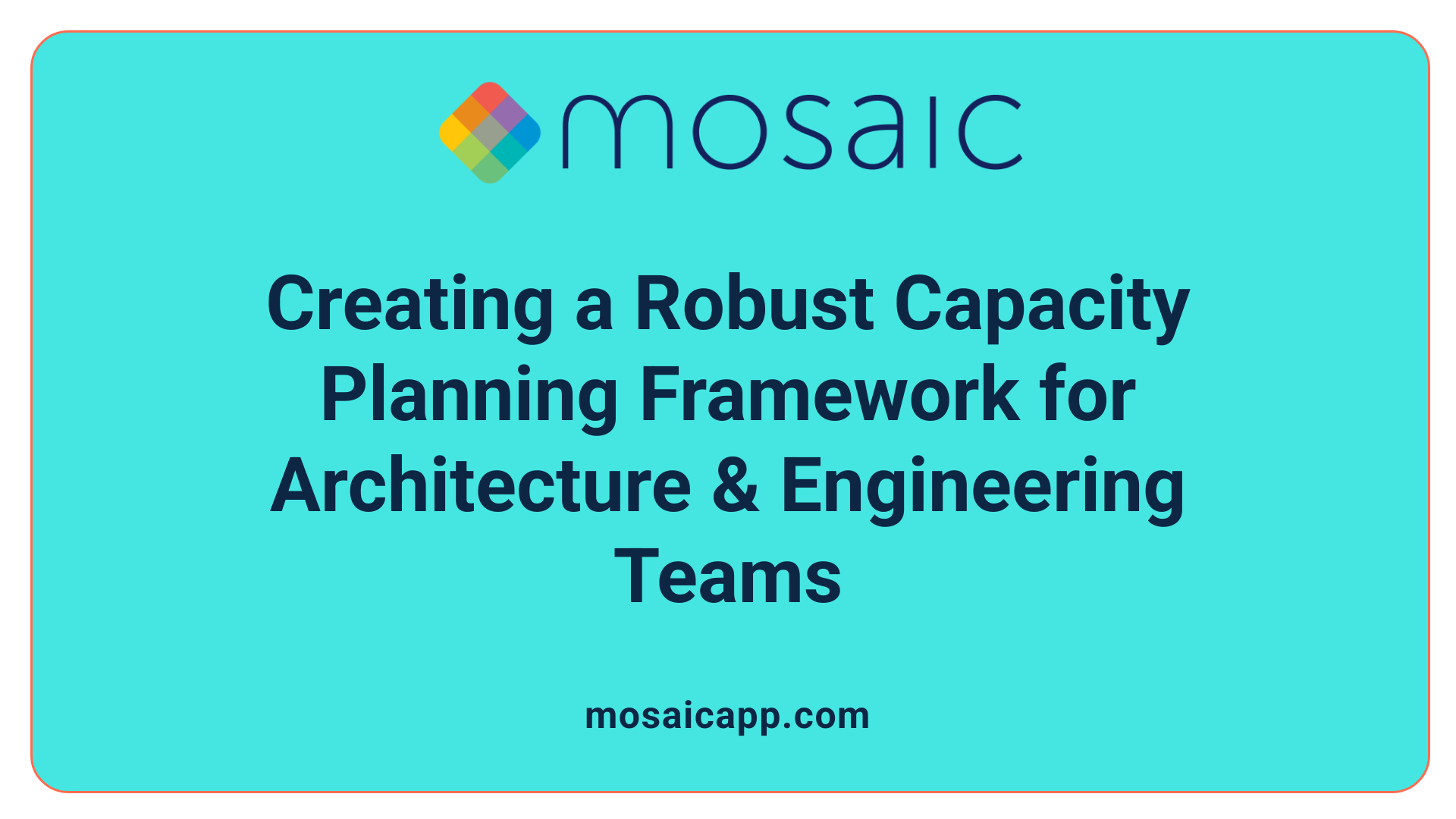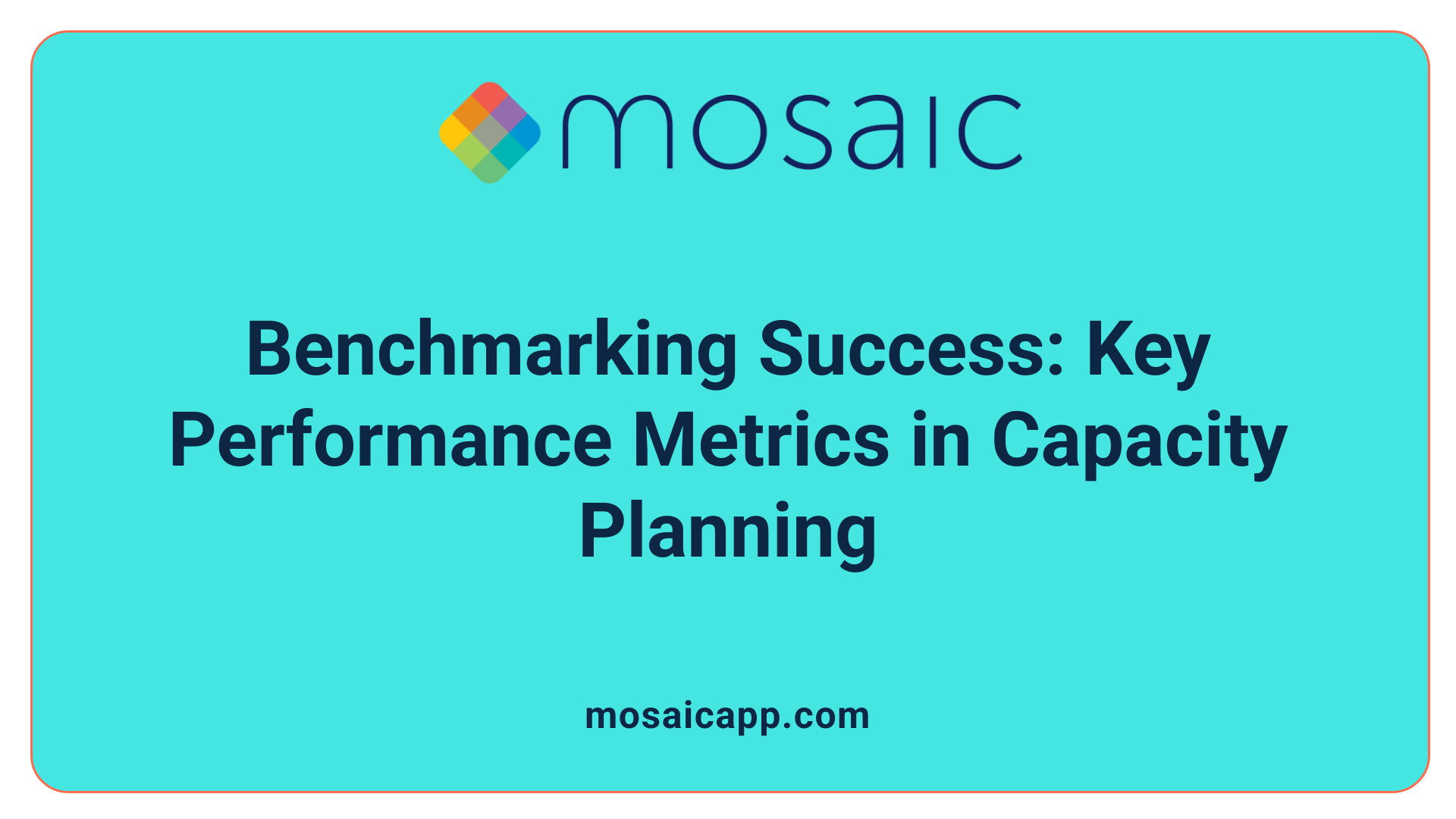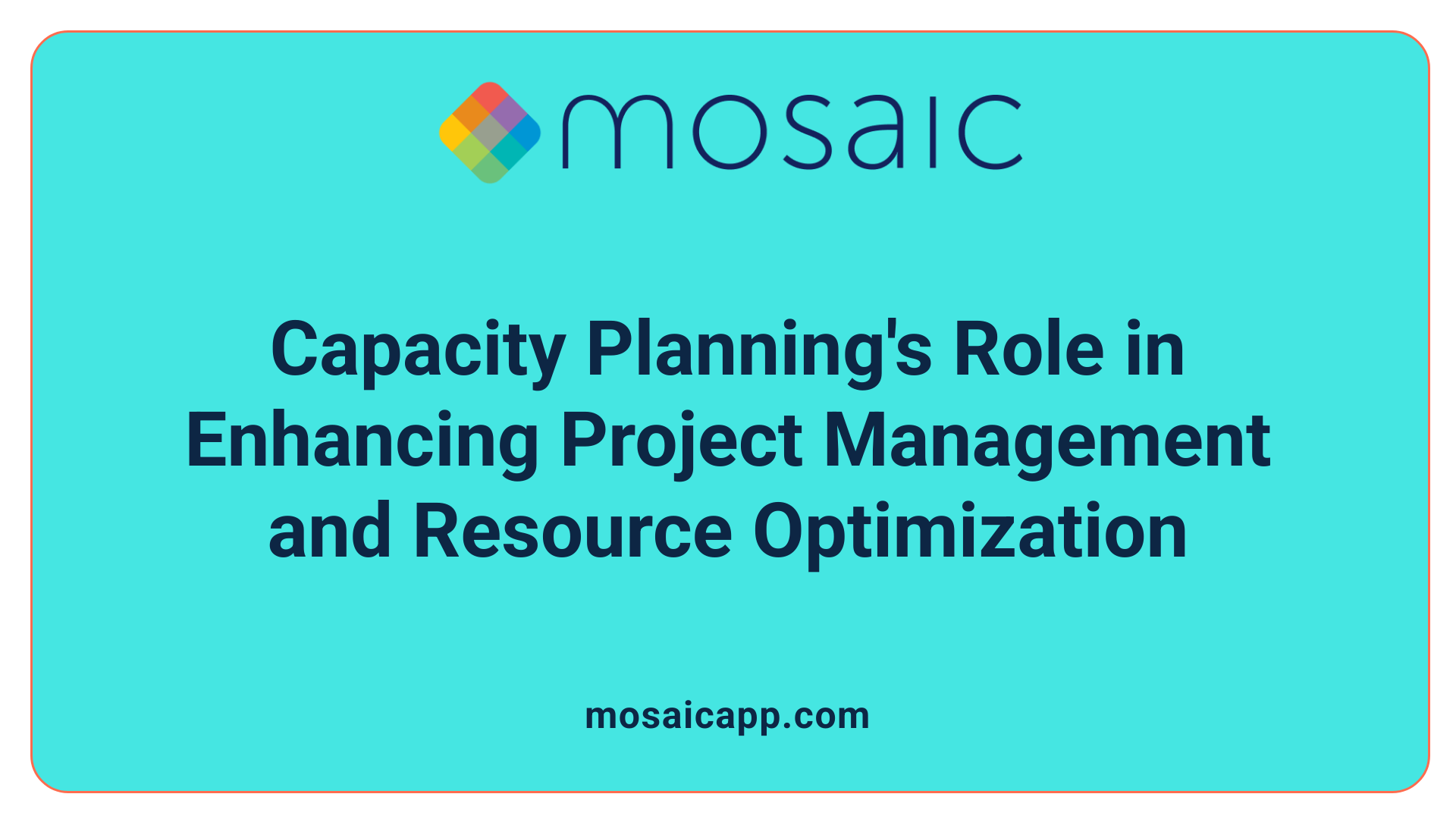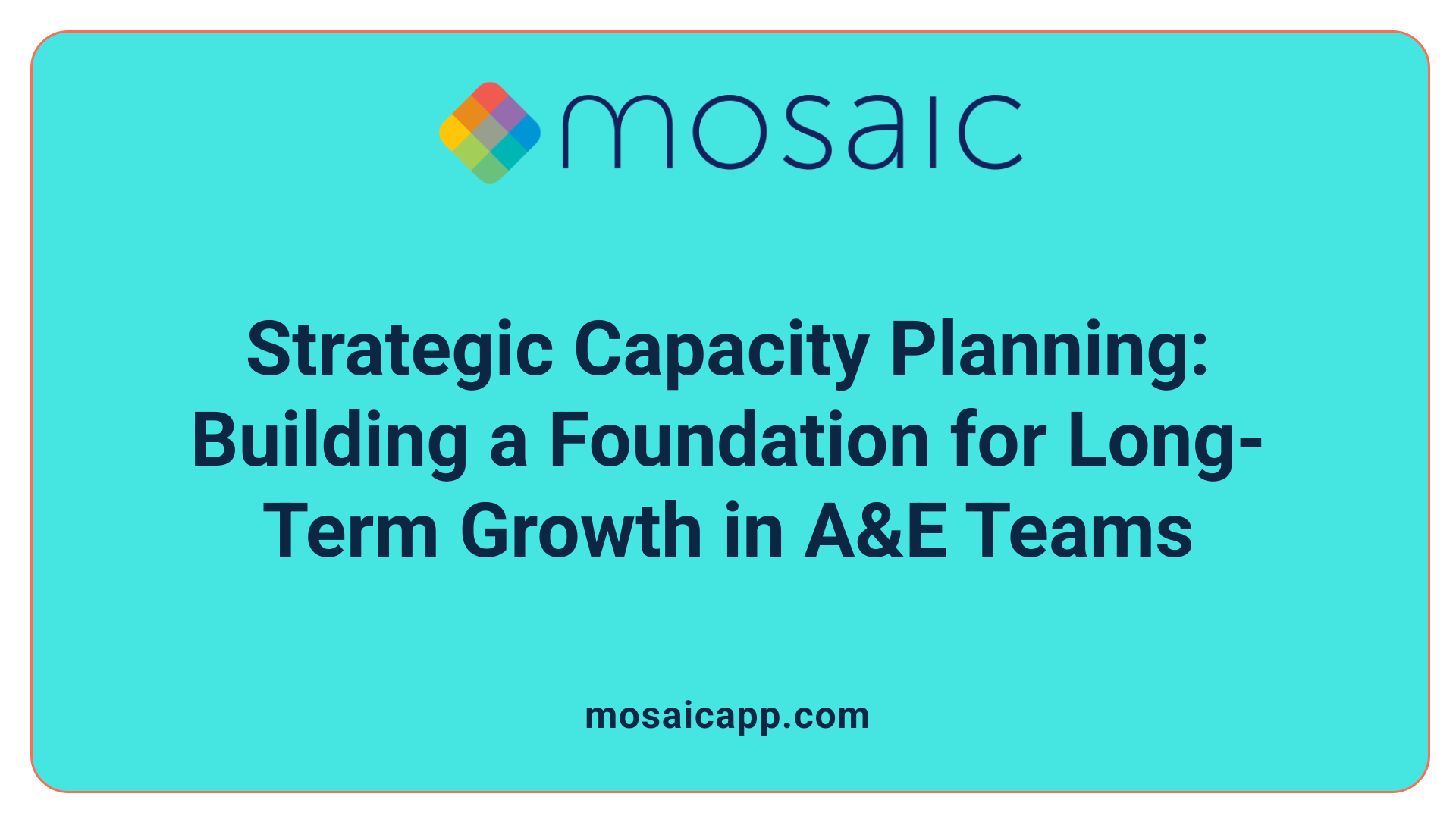Understanding the Strategic Role of Capacity Planning in Emergency Medicine
Capacity planning is an integral component of effective management in Accident & Emergency (A&E) teams. It ensures that resources, personnel, and equipment are aligned with patient demand, maximizing efficiency and reducing wait times. The complexity of A&E environments—marked by unpredictable patient inflows, diverse case severity, and the need for rapid response—demands a strategic approach to resource allocation. This guide explores the fundamental principles, best practices, tools, and metrics essential for optimizing capacity and enhancing service delivery.
The Foundation of Capacity Planning in A&E Teams
What is the importance of capacity planning for architecture and engineering teams?
Capacity planning plays a vital role in the success of architecture and engineering (A&E) teams. It involves analyzing the current workforce, understanding their skills and availability, and matching these resources with upcoming project demands. This strategic process ensures that staffing levels are optimized to meet project deadlines without overloading team members.
A well-developed capacity plan includes a detailed inventory of resources, forecasting future needs based on upcoming projects, and mapping resources to project timelines. It also entails tracking how intensively resources are used and preparing contingency plans for unforeseen demands. By doing so, teams can prevent shortages and avoid excess capacity, which could lead to inefficiencies.
Effective capacity planning enhances project delivery by balancing workloads, reducing the risk of burnout, and maintaining high quality standards. When teams operate with a clear view of their capacity, they can allocate work smarter and adapt quickly to changes, such as scope creep or urgent projects. This proactive approach leads to better utilization of resources, increased profitability, and overall project success.
Moreover, leveraging resource management software like Deltek Vantagepoint can provide real-time data, capacity dashboards, and scenario planning tools. These technologies support continuous monitoring and quick adjustment of resource allocations, ensuring that planning remains accurate as conditions evolve.
Why is balance among workloads important?
Balancing workloads is crucial not only for maintaining team wellbeing but also for meeting project deadlines effectively. When workloads are uneven, some team members may become overburdened, risking fatigue and errors, while others may be under-utilized, leading to wasted resources.
A balanced approach helps distribute tasks evenly across the team, fostering a more sustainable work environment. It enables staff to focus on their strengths, reduces burnout, and promotes job satisfaction. Additionally, balanced workloads contribute to higher quality outcomes, as team members are less likely to rush or make mistakes under pressure.
Tools such as capacity utilization reports and resource leveling techniques assist managers in tracking how resources are being used. They can identify imbalances early, allowing for quick reallocation of tasks or staffing adjustments.
How does capacity planning impact patient care and staff wellbeing?
While capacity planning is often discussed in healthcare contexts, its principles are equally vital for A&E firms in architecture and engineering. When resource planning is effective, teams can meet project demands without overextending staff, leading to less stress and improved morale.
Proper planning helps prevent burnout by avoiding excessive workloads and allowing for better work-life balance. It also ensures that deadlines are realistic, which minimizes last-minute rushes and quality compromises.
By systematically anticipating staffing needs, organizations can also schedule time off, training, and professional development opportunities without disrupting workflows. This foresight supports staff wellbeing and creates a more resilient, committed workforce.
In summary, sound capacity planning forms the backbone of successful project delivery in A&E teams. It fosters balanced workloads, enhances productivity, and promotes a healthy, sustainable working environment that benefits both staff and clients.
Overview of Capacity Planning Techniques and Strategies
| Aspect | Details | Benefits |
|---|---|---|
| Data Analysis | Uses past project data and current workforce skills to forecast needs | Helps identify capacity gaps and plan effectively |
| Resource Inventory | Catalogs skills, availability, and current assignments | Ensures accurate matching of resources to project demands |
| Forecasting | Projects future workload based on upcoming projects | Prepares teams for future needs and avoids surprises |
| Capacity Utilization | Measures current usage against maximum capacity | Promotes optimal use of resources |
| Strategies | Lag, lead, match – to either meet current or forecasted demand | Balances risks and optimizes resource deployment |
| Software Tools | Dashboards, real-time data, scenario analysis | Facilitates quick adjustments and data-driven decisions |
Understanding and applying these techniques ensures that architecture and engineering organizations can deliver projects efficiently while maintaining a healthy work environment.
Key Components of an Effective Capacity Plan for A&E
Resource inventory and skills cataloging
A comprehensive resource plan begins with creating a detailed inventory of all team members and their skills. This includes identifying each individual’s expertise, certifications, experience levels, and available hours. By understanding the skills within the organization, project managers can assign the right people to the right tasks, enhancing efficiency and quality.
Maintaining an up-to-date skills catalog helps in quickly filling skill gaps and identifying potential training needs. This process supports strategic decision-making when assigning resources to current and upcoming projects.
Forecasting during peak times and emergencies
Forecasting plays a vital role in capacity planning, especially during peak workload periods or emergencies. Analyzing historical project data helps predict periods of high demand, enabling firms to prepare by adjusting resource availability.
This foresight is crucial for managing sudden surges, such as urgent project deadlines or unforeseen client demands. Proper forecasting can involve creating scenarios for various peak periods and planning resource allocation accordingly.
Mapping resource availability with project timelines
Aligning resource availability with project schedules is essential for smooth execution. This involves mapping the current capacity of team members against upcoming project timelines, considering factors like planned vacations, training, or leaves.
Effective mapping ensures that critical projects have sufficient staffing while avoiding overallocation or underutilization. This proactive approach helps meet project deadlines and maintains quality standards.
Contingency planning for surges
No plan is complete without preparing for unexpected changes or surges in demand. Contingency planning involves identifying potential risks, such as scope creep or regulatory changes, and developing backup strategies.
These may include cross-training staff, creating a pool of freelance or subcontractor resources, or adjusting project timelines. Well-designed contingency plans provide flexibility, allowing firms to respond swiftly without compromising project quality or team well-being.
Why capacity planning is vital for A&E teams
Effective capacity planning is fundamental for architecture and engineering firms. It helps balance workloads, prevent burnout, and ensure projects are completed on time. It also improves resource utilization, reducing costs and increasing profitability.
By forecasting demand, mapping resources, and preparing for disruptions, firms can optimize project delivery. This strategic approach supports long-term growth and enhances the firm's reputation for reliability.
Software tools supporting capacity planning
Modern tools like Deltek Vantagepoint facilitate real-time data tracking, capacity dashboards, and scenario planning. These software solutions provide visibility into resource utilization and help managers make informed adjustments quickly.
Using such tools ensures that capacity planning remains dynamic and adaptable, accommodating changes in project scope or staffing levels.
| Component | Purpose | Benefits | Tools & Techniques |
|---|---|---|---|
| Resource Inventory | Catalog team skills | Efficient task assignment | Resource breakdown structure |
| Forecasting Demand | Anticipate peak times | Prevent resource shortages | Historical data analysis |
| Resource Mapping | Align availability with schedules | Meet deadlines | Capacity dashboards |
| Contingency Planning | Prepare for surges | Flexibility in operations | Scenario analysis, cross-training |
In conclusion, building a solid capacity plan requires understanding current resources, anticipating future needs, and preparing for uncertainty. Incorporating software tools and continuous monitoring helps maintain optimal resource utilization, ensuring project success and organizational growth.
Building a Robust Capacity Planning Framework

What are best practices for effective capacity planning in architecture and engineering teams?
Effective capacity planning in architecture and engineering (A&E) teams requires a comprehensive approach that combines detailed resource assessment with flexible strategies to adapt to project needs. A foundational practice involves systematically cataloging the skills and expertise of each team member. This includes creating a detailed inventory of individual competencies, experience levels, and availability, which forms the basis for matching personnel to project tasks.
Analyzing past demand data is equally important to forecast future workload requirements accurately. Reviewing historical project performance helps identify trends, peak periods, and potential resource bottlenecks. Combining this data with upcoming project forecasts allows managers to anticipate staffing needs and plan accordingly.
To keep a close eye on current utilization and future needs, leveraging specialized resource management software is vital. Tools like Deltek Vantagepoint or Chrono Platform enable real-time visibility into resource allocation, capacity dashboards, and scenario planning. These platforms support continuous monitoring, which helps prevent over or under-utilization of staff, minimizing burnout and maximizing efficiency.
Strategies such as lag, lead, and match are valuable in balancing demand and supply. Lag strategy involves building capacity gradually to match current needs, suitable for unpredictable or variable workloads. Lead strategy involves expanding capacity in anticipation of upcoming demands, ensuring resources are ready before work begins. Match strategy seeks to align capacity closely with immediate requirements, minimizing excess capacity and avoiding waste.
Incorporating flexibility into resource planning also involves considering outsourcing or temporary staffing to cover specialized skills or peak periods. Upgrading technology tools and infrastructure supports faster, more accurate planning and adjustments, ensuring teams remain agile.
Ultimately, the best practices emphasize ongoing review and adaptation. Continuous feedback from project teams, regular updates to resource inventories, and scenario analyses ensure capacity planning remains aligned with business goals and project demands. This proactive, dynamic approach helps organizations avoid bottlenecks, manage workloads effectively, and meet project timelines consistently.
Tools and Technologies for Capacity Planning in A&E

What tools and software solutions are available for capacity planning in architecture and engineering teams?
In the architecture and engineering (A&E) sector, effective capacity planning relies heavily on a suite of specialized software tools designed to streamline resource management and project scheduling. Several industry-standard platforms serve this purpose, offering comprehensive features to facilitate accurate demand forecasting, workload balancing, and real-time monitoring.
Prominent project management solutions include Autodesk, Primavera, and Microsoft Project. These platforms provide robust functionalities such as Gantt chart visualization, resource allocation tracking, and timeline management, helping teams visualize project scopes against available capacity.
Beyond general project management tools, specialized software like Epicflow and Jellyfish address the unique needs of A&E firms. These tools excel in workload forecasting, scenario analysis, and competency management. Epicflow, for instance, enables project managers to model different resource allocation scenarios, identify bottlenecks, and optimize workloads across multiple projects. Jellyfish offers real-time analytics, skills tracking, and integration with collaboration tools like Jira and GitHub, improving transparency and responsiveness.
Industry-specific solutions such as Deltek Vantagepoint are tailored for A&E operations. This platform provides detailed functionalities such as demand forecasting, resource utilization tracking, and workflow management, all aligned with the industry's unique project delivery models. It also offers customizable dashboards and reports to facilitate strategic planning and operational adjustments.
Most of these tools leverage advanced features including workload forecasting, capacity dashboards, and scenario analysis. They often incorporate predictive modeling to simulate future demands and resource availability, enabling proactive planning. Real-time data integration ensures project teams can make swift decisions, minimize risks, and adapt to changes effectively.
In summary, a variety of software options are available to enhance capacity planning in A&E environments. They empower firms to allocate resources wisely, meet project deadlines, and optimize utilization rates. The choice of tools often depends on the specific needs of the organization, project complexity, and integration capabilities.
| Tool/Platform | Focus Area | Main Features | Industry Use Case |
|---|---|---|---|
| Autodesk, Primavera, MS Project | General project/resource management | Gantt charts, resource views, scheduling tools | Overall project planning, timeline management |
| Epicflow, Jellyfish | Advanced workload forecasting | Scenario analysis, competency management, integrations | Multi-project resource balancing, capacity modeling |
| Deltek Vantagepoint | Industry-specific solutions | Demand forecasting, utilization, workflows | Strategic planning, reporting tailored to A&E firms |
Using the right combination of these tools can significantly improve capacity planning precision, operational efficiency, and project success rates.
Measuring and Analyzing Resource Utilization
Understanding how resources are utilized in architecture and engineering (A&E) projects is essential for project success and organizational efficiency. Teams measure resource utilization by calculating specific metrics that reveal how effectively their workforce and assets are being employed.
A primary metric is the utilization rate, often expressed as a percentage, which compares billable hours to total hours worked. For example, if an employee logs 40 hours, of which 32 are billable, their utilization rate is 80%. High utilization rates suggest productive use of resources, while lower rates may indicate underutilization or inefficiencies.
To gather and analyze this data, firms often rely on project management tools, time-tracking systems, and real-time dashboards. These tools provide detailed insights into how resources are allocated across projects, whether team members are overloaded, or if some are underused. Visual dashboards help managers quickly identify potential bottlenecks and balance workloads effectively.
An important aspect of optimizing resource use is balancing billable and non-billable hours. While billable work directly generates revenue, non-billable activities such as training, meetings, and administrative tasks support overall productivity. Effective management ensures non-billable efforts are minimized or strategically allocated to foster better project throughput.
Forecasting future needs is another crucial element. By analyzing historical utilization data and current project pipeline, firms can predict staffing requirements for upcoming projects. This foresight helps prevent resource shortages or excess capacity, minimizing idle time or project delays.
Modern resource management software plays a vital role in this process. Solutions like Deltek Vantagepoint offer features such as capacity dashboards, real-time utilization reports, resource allocation tools, and scenario planning. These allow managers to adjust plans quickly, respond to project scope changes, and avoid burnout among team members.
Integrating centralized data systems and advanced analytics enables organizations to make informed decisions swiftly. This approach not only improves overall resource utilization but also contributes to higher profitability and project quality.
In summary, effective measurement and analysis involve calculating utilization rates, utilizing dashboards for ongoing monitoring, balancing different types of work, and employing forecasting techniques. Doing so ensures that resources are aligned with project demands, fostering organizational agility and project success.
Benchmarking and Performance Metrics in Capacity Planning

What are key performance metrics for capacity planning in architecture and engineering?
Effective capacity planning in architecture and engineering (A&E) firms involves continually measuring performance to ensure resources are used efficiently and projects stay on schedule. Several metrics are essential for gauging success and identifying areas for improvement.
Resource utilization rates are among the most important. Typically, most A&E firms operate best when their workforce utilization hovers between 80% and 90%. Industry averages tend to be around 82.4%, with top-performing firms pushing closer to 95.2%, achieving maximum profitability. These rates reflect the percentage of available capacity that is actively engaged in billable work.
Operational metrics such as throughput and cycle time help monitor project flow. Throughput measures how many projects or tasks are completed over a certain period, while cycle time tracks the duration from project start to completion. These metrics aid in identifying bottlenecks and improving process efficiency.
Financial metrics play a key role too. Return on investment (ROI), profit per unit, and overall project profitability are vital for assessing whether capacity allocation generates anticipated financial returns. These indicators support decisions about scaling resources up or down.
Flexibility and quality are also critical. Changeover time and volume flexibility measure a firm's ability to adapt to evolving project scopes or shifting client demands. Quality metrics, including defect rates or scrap percentage, ensure that increased capacity does not compromise project quality.
Regularly tracking these indicators provides a comprehensive view of operational health. By benchmarking performance against industry standards, like the 82.4% average utilization, firms can pinpoint performance gaps.
How do industry averages and top performers compare?
Industry data shows a typical resource utilization rate of around 82.4% for architecture firms. This balance enables efficiency without overloading staff, which can lead to burnout.
Top quartile A&E firms operate at about 95.2%, maximizing their capacity to deliver more projects or faster turnaround times while maintaining quality. These firms often utilize advanced capacity management tools and strategic planning frameworks to optimize resource use.
Below is a comparison table illustrating different performance levels:
| Performance Level | Utilization Rate | Focus Area | Additional Notes |
|---|---|---|---|
| Average Industry | 82.4% | Efficiency | Balances workload and burnouts |
| Top Quartile | 95.2% | Profitability | Maximizes output with optimized processes |
What operational and financial metrics are used?
Operational metrics include throughput, measuring project completion rates, and cycle time, which reveals process delays.
Financial metrics encompass ROI, profit per project or unit, and cost capacity, helping firms evaluate economic effectiveness of their staffing and resource allocations.
Quality metrics like defect rates or project rework percentages are tracked to preserve high standards amid increased capacity.
Additionally, flexibility indicators such as changeover time and setup speed demonstrate a firm's ability to respond to demand fluctuations.
How do these metrics support capacity planning?
Monitoring these performance metrics allows firms to adjust resource allocations proactively, ensure projects meet deadlines, and avoid costly overruns.
By understanding and benchmarking their performance against industry standards, architecture and engineering firms can continuously refine their capacity strategies, leading to better workload balance, higher profitability, and improved service quality.
Ultimately, integrating these metrics into overall capacity planning fosters a culture of continuous improvement and strategic growth.
The Impact of Capacity Planning on Project Management

How can implementing capacity planning processes enhance project management and resource allocation?
Implementing capacity planning practices significantly boosts the effectiveness of project management and resource distribution within an organization. By thoroughly analyzing what current resources—such as workforce skills, availability, and tools—are capable of handling, managers gain a clear picture of what can be achieved. This ongoing process involves creating a detailed resource inventory, forecasting future project demands, and mapping these demands against capacity.
A well-designed capacity plan fosters proactive scheduling by alerting managers to potential overloads or shortages before they impact project timelines. It enables teams to balance work assignments evenly, reducing burnout and improving morale. By tracking real-time resource utilization through advanced management software, organizations can make informed adjustments swiftly, avoiding delays and minimizing idle time.
Early detection of skills gaps is another crucial advantage. If a project requires specialized skills that are scarce or absent, capacity planning highlights these shortfalls early on. This insight allows for targeted interventions like reskilling existing staff or recruiting new talent, ensuring project demands are met without last-minute scrambling.
Furthermore, capacity planning helps optimize costs and meet deadlines. By aligning staffing levels with project needs, organizations can prevent resource misallocation—either over-utilization, which risks burnout and errors, or under-utilization, leading to wasted expenses. Accurate forecasting and efficient scheduling contribute to maintaining budget targets and adhering to set timelines.
In addition to operational benefits, strategic capacity planning supports long-term growth. Frameworks like lag, lead, and match strategies enable firms to forecast future workforce needs based on upcoming projects, balancing risk with demand. It empowers leadership to allocate resources effectively across multiple projects, even in complex environments like architecture and engineering firms, which often face overlapping deadlines, specialized skill requirements, and scope changes.
In summary, integrating capacity planning into project management protocols leads to better resource visibility, efficient utilization, early problem detection, cost savings, and improved project outcomes. The continuous adjustment of resource allocations ensures that teams remain productive, projects stay on track, and organizations adapt seamlessly to evolving demands.
Strategic Capacity Planning for Long-Term Success in A&E

What frameworks are used: lag, lead, and match strategies?
In capacity planning, different frameworks offer tailored approaches to meet project demands and manage risks. The lag strategy involves scaling capacity after a demand increase has already occurred, which can lead to delays but minimizes overinvestment. The lead strategy proactively increases capacity ahead of anticipated growth, ensuring readiness but potentially incurring higher costs if demand forecasts are inaccurate. The match strategy strikes a balance, gradually adjusting capacity in line with demand changes as they happen, providing flexibility and cost efficiency.
How can forecasting future demand build resilience?
Forecasting future demand is essential for preparing your workforce and resources for upcoming projects or fluctuations. By analyzing historical data, project pipelines, and industry trends, A&E firms can project workload levels over months or years. This foresight allows for strategic hiring, training, and investment in infrastructure. Accurate demand forecasting reduces the risk of shortages or excess capacity, making teams more adaptable and resilient to market changes.
How do we align staffing with growth plans?
Aligning staffing with growth plans involves assessing current capacity and identifying gaps relative to future project commitments. This process includes detailed resource inventories, skill assessments, and capacity utilization analysis. As growth plans evolve, maintaining flexibility is also crucial—this might involve cross-training staff or creating partnerships with freelance professionals. Using capacity planning software can facilitate real-time insights, making it easier to adjust staffing levels proactively and support expansion goals.
How does strategic capacity planning support innovation and scalability?
Effective capacity planning fosters innovation by freeing up resources for research, experimentation, or adopting new technologies. It ensures that core operations run smoothly, providing a stable platform for strategic initiatives. Scalability is supported by maintaining flexible resource pools and strategic reserves, allowing firms to ramp up operations when new opportunities arise without disrupting ongoing projects. By integrating capacity planning into the organizational strategy, A&E firms can adapt to industry shifts and scale efficiently.
How can strategic capacity planning improve efficiency and workload management in A&E teams?
Strategic capacity planning enhances efficiency and workload management in A&E teams by accurately forecasting future demand and aligning resources accordingly, ensuring that staff and equipment are available when needed. It helps prevent bottlenecks and overburdening by identifying capacity gaps early, allowing for proactive adjustments such as hiring, training, or reallocating staff. Implementing best practices like resource pooling, continuous monitoring, and use of capacity planning software improves decision-making and resource utilization. Balancing workloads through strategic foresight reduces stress and burnout among team members, leading to higher morale and productivity. Ultimately, it allows A&E teams to deliver timely patient care, optimize resource use, and adapt effectively to fluctuations in demand.
Implementing Capacity Planning: From Strategy to Practice
Step-by-step process overview
Effective capacity planning in architecture and engineering (A&E) firms begins with a clear understanding of current resources and project demands. The first step involves cataloging all team members, their skills, and availability. This detailed resource inventory allows firms to forecast future demand by analyzing upcoming project requirements and historical data. Using this information, organizations can map resource availability to project timelines, identifying potential gaps or excess capacity.
The next stage is developing a comprehensive capacity plan, which includes forecasted resource needs, schedules, and contingency strategies. Employing resource management software like Deltek Vantagepoint facilitates real-time data collection, resource allocation, and scenario analysis. Once the plan is in place, scheduling resources efficiently according to project priorities helps align workforce capacity with delivery deadlines.
Monitoring and adjusting plans
Monitoring involves tracking resource utilization continuously through capacity dashboards and reports generated by resource management tools. Firms should analyze metrics such as billable versus non-billable hours and overall capacity utilization, aiming for optimal levels typically between 80% and 90%. When deviations occur—such as over-utilization leading to burnout, or under-utilization causing idle time—adjustments are necessary.
Flexibility is critical. Organizations should be prepared to reallocate resources swiftly, accommodate scope changes, or adjust project timelines. Regular reviews and ongoing data analysis enable proactive decision-making, preventing bottlenecks and ensuring projects stay on track.
Documentation and lessons learned
Documenting lessons learned throughout the capacity planning process is essential for continuous improvement. Recording what strategies worked, what challenges arose, and how issues were resolved provides valuable insights for future planning cycles. This documentation should include data on resource utilization rates, scheduling adjustments, and stakeholder feedback.
Sharing this knowledge enhances organizational learning, informs process refinements, and supports strategic resource allocation. It also helps in developing best practices tailored to the unique needs of A&E projects.
Embedding capacity planning into organizational culture
To make capacity planning a routine part of operations, firms must integrate it into their organizational culture. This involves training staff on planning tools and methodologies, emphasizing the importance of data-driven decisions, and encouraging collaboration among project teams.
Leadership should promote transparency regarding resource constraints and foster a mindset of adaptability. Regular communication about capacity status and planning outcomes reinforces its value, ensuring that resource considerations influence project proposals, staffing decisions, and strategic growth plans.
By embedding these practices into daily workflows, A&E firms can enhance resilience, improve project delivery, and better respond to shifting demands.
How can teams measure, analyze, and optimize resource utilization in A&E projects?
Teams can measure resource utilization by calculating metrics such as the percentage of billable hours relative to total hours worked. This provides a clear indication of workforce efficiency. Analyzing this data through project management systems, time-tracking software, and dashboards reveals patterns of over- or underutilization.
Optimization involves balancing billable and non-billable work, streamlining tasks with automation, and leveraging resource management tools for real-time visibility. Incorporating centralized data systems and ERP solutions allows firms to swiftly adapt to project changes, reduce waste, and maximize profitability.
Implementing these measurement and analysis strategies fosters better resource distribution, improves project outcomes, and enhances organizational agility.
Building a Future-Ready A&E Team Through Capacity Planning
Optimizing capacity in A&E teams is not a one-time effort but a continuous process that fosters resilience, efficiency, and excellence in patient care. Leveraging best practices, advanced tools, and ongoing performance analysis enables organizations to adapt swiftly to changing demands while maintaining high standards. A strategic approach to capacity planning lays the foundation for sustainable growth, improved project delivery, and a healthier work environment. By embracing these principles, A&E teams can ensure they are equipped to meet current challenges and future opportunities, thereby advancing excellence in healthcare delivery.
References
- Resource Capacity Planning for A&E Firms: Full Guide
- Calculating Capacity Utilization: A Step-by-Step Guide for ...
- The Beginner's Guide to Capacity Planning for 2025 & ...
- Project Resource Management for A&E Firms: 6 Steps + Tips
- The Ultimate Guide to Capacity Planning
- Engineering capacity planning: process, strategies, tools
- What is Capacity Planning? Types, Strategies & Best ...
- Strategic Capacity Planning – And How to Improve It
- 12 Best Capacity Planning Tools for Resource ...


